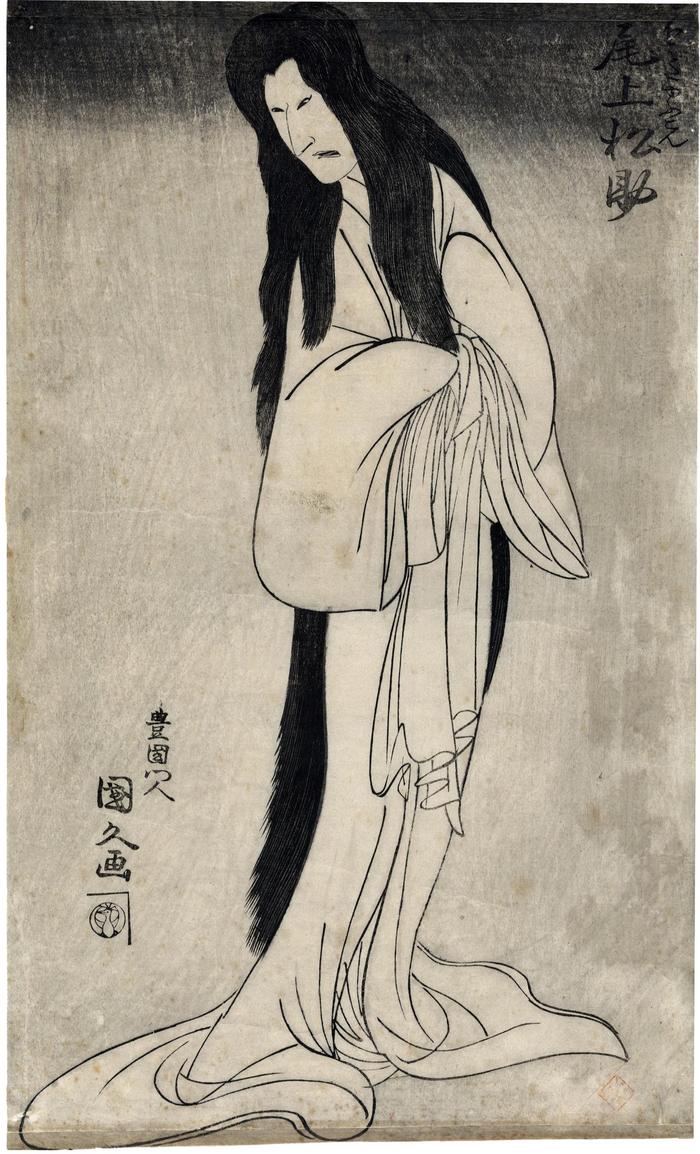Utagawa Kunihisa (歌川国久) (artist )
Onoe Matsusuke I (尾上松助) as the ghost of the wet-nurse Iohata (‘Iohata bokon’) in the play Tenjiku Tokubei ikoku banashi (天竺徳兵衛韓噺)
07/1804
8.75 in x 14.25 in (Overall dimensions) Japanese color woodblock print
Signed: Toyokuni monjin Kunihisa ga
(Toyokuni's student Kunihisa drew this picture)
豊国門人国久画
Publisher: Tsuruya Kinsuke (Marks 554 - seal 06-002)
Waseda University
British Museum
Rijksmuseum
Lyon Collection - another Kunihisa print of the ghost of Iohata According to Hideo Furuido Iohata starts its theatrical life as a ghost in a puppet play from Chikamatsu Hanji. Furuido wrote: "... I came to realize that the entire kabuki play, including the domestic scene in which the ghost of Iohata appears and the scene featuring the quick change in the water, neither of which has left any direct trace in modern performance, was essentially an adaptation of Hanji’s jōruri play. Tokubei from India wasn’t actually a new play at all.... That said, it is important to recognize that the kabuki play took the work in new directions, as the subtitle for Nanboku’s 1804 production suggests: “A kabuki expansion upon a historical and domestic jōruri play.” "
Later Furuido wrote: "Matsusuke’s involvement in summer ghost plays originated with Iohata’s ghost, which he played on more than one occasion. The jōruri play Tenjiku Tokubei sato no sugatami—an earlier work—had included the ghost of a girl named Oshio, but a ghost played by a child actor was not at all the same thing as a kabuki horror ghost play performed by adult men. The idea of bringing back Iohata—who, in the puppet version of the play, was simply killed by Tokubei—as a ghost may well have been an innovation of Nanboku’s, given his willingness to break existing taboos, drawing in a remarkably astute manner on trends from narrative fiction of the time."
Quoted from: 'Tokubei from India: A Blind Performer and the Shogun’s Envoy',
****
This rare, majestic ghost print is by Toyokuni I's early and talented female pupil Kunihisa, who produced only a handful of superb designs in the early manner of Toyokuni I. Unidentified Japanese collector's seal at base.
****
"A female print designer of whom a few prints of actors and beautiful women are known. Binyon and Sexton, 1923, p. 155, lists two prints, one of which, a portrait of an actor in a female role, now in the Bibliotheque Nationale, Paris, is reproduced in the Cat. Hayashi sale, 1905.
Utagawa Kunihisa was one of Toyokuni's earliest pupils. Apart from prints some paintings by her are also known." Quoted from: Catalogue of the Collection of Japanese Prints Part IV - Hiroshige and the Utagawa School, Rijksprentkabinet/Rijksmuseum, 1984, no. 188, p. 108. This is accompanied by a small black and white illustration.
****
This play was composed (partially?) by Katsu Hyōzō I (Tsuruya Nanboku IV - 四代目鶴屋南北).
****
Often in kabuki theater ghosts are represented by figures in white robes, but not always. The white robe is similar to a katabira, a summer robe, but it is referred to as a kyōkatabira (経帷子). After a person died their body was washed, often by female family members, and prepared in a certain way. At the end, whether Shintō or Buddhist, they were dressed in a white garment to start them on their next (spiritual/afterlife) journey. "Three women of the community followed strict rules in making the death robe. They measured the cloth by hand instead of with a ruler, tore the cloth instead of cutting it with scissors, sewed the seams so that the stitches were visible, left the ends of the threads unknotted, and made no collar. Making the garment different from the clothes worn by the living emphasized the contrast between life and death..." That is why we see the figure of Iohata in a loose white robe in this print.
****
Illustrated:
1) in black and white in Ukiyo-e Masterpieces in European Collections: British Museum III, supervised by Muneshige Narazaki, Kodansha Ltd, 1988, #20, page 170.
2) in a black and white illustration in volume IV of Japanese Prints in the Rijksmuseum: Hiroshige and the Utagawa School, Riksprentkabinet/Rijksmuseum, 1984, no. 188, p. 108.
Tsuruya Kinsuke (鶴屋金助) (publisher)
Yūrei-zu (幽霊図 - ghosts demons monsters and spirits) (genre)
actor prints (yakusha-e - 役者絵) (genre)
Onoe Matsusuke I (初代尾上松助: 11/1755 to 10/1809) (actor)
Tsuruya Nanboku IV (四代目鶴屋南北) (author)
